Peloton Business Model Canvas 2024
Peloton, a revolutionary fitness company that seamlessly blends cutting-edge technology with engaging workouts, has transformed the way people exercise at home. In this Peloton Business Model Canvas, I will identify its customer segments, value proposition, revenue streams, channels, customer relationships, key activities, key resources, key partners, and cost structure.
Interesting fact!
Peloton instructors have their own secret language of hand signals to communicate with the production team during live classes.
Peloton Competitors
Echelon | NordicTrack | MYX Fitness | Bowflex | Life Fitness | SoulCycle/Equinox+/Variis | Mirror | Flywheel Sports | Keiser | Technogym
Customer Segments – Peloton Business Model Canvas

Affluent Fitness Enthusiasts: The segment comprises individuals with high disposable incomes who prioritize fitness and wellness. They seek premium, high-quality fitness equipment and are willing to invest in a personalized home workout experience.
Time-Constrained Professionals: Busy professionals who value convenience and efficiency form this segment. They seek efficient workouts that can be integrated into their hectic schedules, often opting for shorter, high-intensity classes.
Health-Conscious Individuals: The segment includes individuals who are focused on improving their overall health and well-being. They are motivated by health goals such as weight loss, muscle gain, or stress reduction and seek workouts that align with their specific needs.
Social Fitness Community Seekers: The segment is drawn to the social aspect of fitness and enjoys the camaraderie and motivation provided by a virtual community. They actively participate in challenges, leaderboard competitions, and social media groups.
Tech-Savvy Consumers: The segment comprises individuals who are early adopters of technology and appreciate the innovative features offered by Peloton. They enjoy the interactive experience, data tracking capabilities, and the ability to customize their workouts.
Value Proposition – Peloton Business Model Canvas
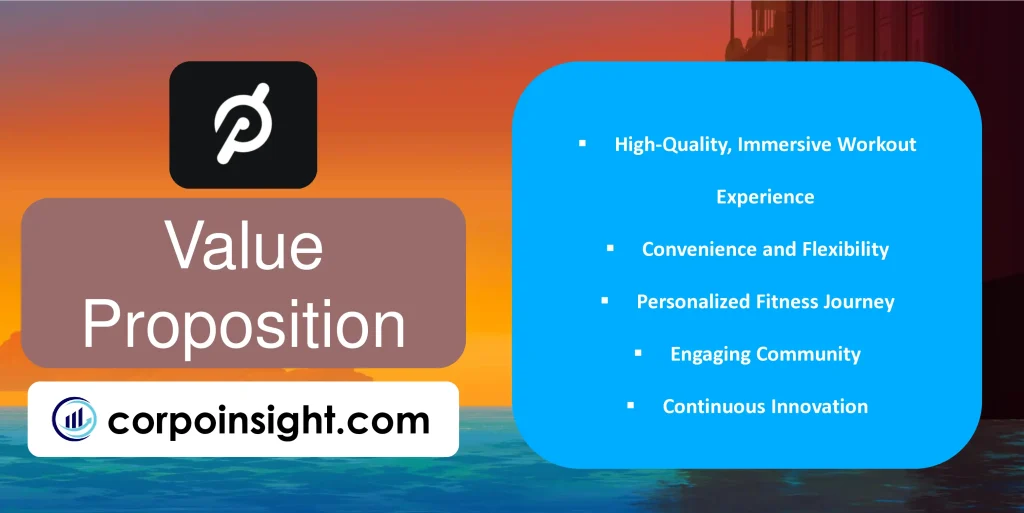
High-Quality, Immersive Workout Experience: Peloton offers a premium fitness experience that rivals traditional gyms, providing high-definition classes led by world-class instructors and state-of-the-art equipment.
Convenience and Flexibility: Peloton’s home fitness solution eliminates the need for gym memberships and allows users to exercise at their convenience, saving time and effort.
Personalized Fitness Journey: Peloton’s technology-driven platform enables users to track their progress, set personalized goals, and receive tailored workout recommendations.
Engaging Community: Peloton fosters a strong sense of community through virtual classes, challenges, and social features, motivating users to stay consistent and achieve their fitness goals.
Continuous Innovation: Peloton consistently introduces new features and content to keep users engaged, such as interactive workouts, music partnerships, and advanced metrics tracking.
Revenue Streams – Peloton Business Model Canvas

Product Sales: Peloton generates significant revenue from the sale of its core products, including stationary bikes, treadmills, and other fitness equipment. These products are sold directly to consumers through Peloton’s website and retail stores.
Subscription Fees: Peloton’s subscription service, Peloton All-Access Membership, provides users with access to a vast library of on-demand and live fitness classes. This recurring revenue stream is a crucial component of Peloton’s business model.
Accessories and Apparel: Peloton offers a range of accessories and apparel, such as bike shoes, heart rate monitors, and workout clothing, which are sold through its website and retail stores. These products complement the core offerings and provide additional revenue streams.
Content Partnerships: Peloton collaborates with artists, musicians, and celebrities to create exclusive content, such as themed rides and workouts. These partnerships can attract new subscribers and generate additional revenue through licensing fees and merchandise sales.
Advertising and Sponsorships: Peloton generates revenue through advertising and sponsorships, which can be integrated into its digital platform and live classes. These partnerships can help to offset the cost of content production and provide additional revenue streams.
Channels – Peloton Business Model Canvas
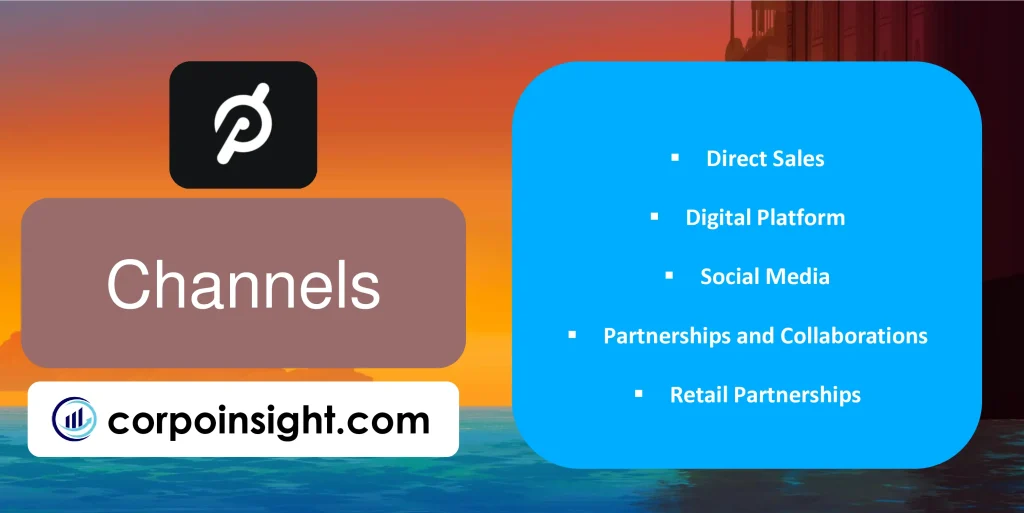
Direct Sales: Peloton operates its own e-commerce platform and retail stores, allowing customers to purchase products directly from the company. This direct-to-consumer model enables Peloton to control the customer experience and pricing.
Digital Platform: Peloton’s digital platform is the primary channel for delivering fitness content to its subscribers. It offers a wide range of on-demand and live classes that can be accessed through various devices, including smartphones, tablets, and smart TVs.
Social Media: Peloton leverages social media platforms like Instagram, Facebook, and TikTok to engage with its audience, share fitness tips, and promote its products and services. Social media also serves as a platform for building a strong brand community.
Partnerships and Collaborations: Peloton collaborates with other companies and organizations to expand its reach and offer additional value to its customers. These partnerships can include collaborations with fitness influencers, music artists, and other brands.
Retail Partnerships: Peloton has partnered with select retailers to offer its products in physical stores. This allows customers to experience the products firsthand and make informed purchasing decisions.
Customer Relationships – Peloton Business Model Canvas

Personalized Experience: Peloton utilizes advanced technology to tailor workouts to individual preferences, tracking progress, and providing personalized recommendations. This creates a sense of individual attention and fosters customer loyalty.
Engaging Community: Peloton cultivates a strong sense of community through virtual classes, challenges, and social media groups. This encourages interaction, motivation, and a shared sense of accomplishment among users.
Excellent Customer Support: Peloton offers robust customer support channels, including live chat, email, and phone support. The company’s dedicated support team is available to assist with product setup, troubleshooting, and general inquiries.
Loyalty Programs: Peloton rewards loyal customers through loyalty programs that offer exclusive perks, discounts, and early access to new products and features. These programs incentivize repeat purchases and long-term engagement.
Data-Driven Insights: Peloton leverages data analytics to gain valuable insights into customer behavior and preferences. This information is used to refine products, improve the user experience, and develop targeted marketing campaigns.
Key Activities – Peloton Business Model Canvas
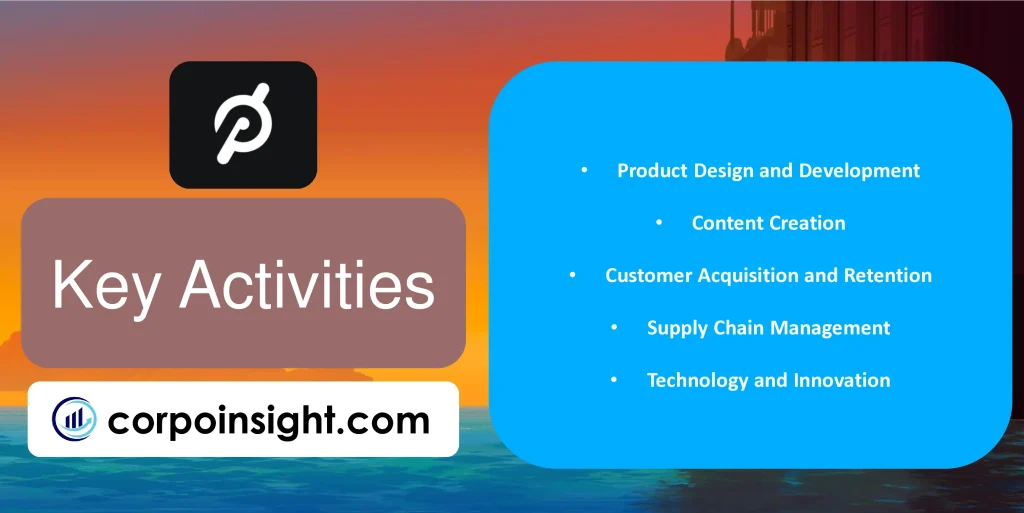
Product Design and Development: Peloton invests heavily in research and development to create innovative fitness products that meet the evolving needs of its customers. This includes designing sleek and functional equipment, developing user-friendly software, and integrating cutting-edge technology.
Content Creation: Peloton produces high-quality fitness content, including live and on-demand classes, featuring a diverse range of instructors and workout styles. The company’s content team works tirelessly to create engaging and effective workouts that motivate and inspire users.
Customer Acquisition and Retention: Peloton employs a multi-channel marketing strategy to attract new customers and retain existing ones. This includes targeted advertising campaigns, social media marketing, influencer partnerships, and referral programs.
Supply Chain Management: Peloton manages a complex supply chain to ensure the efficient production and distribution of its products. This involves sourcing high-quality components, optimizing manufacturing processes, and maintaining strong relationships with suppliers.
Technology and Innovation: Peloton prioritizes technological innovation to enhance the user experience and stay ahead of competitors. This includes developing advanced software platforms, integrating smart features into its products, and leveraging data analytics to personalize the fitness journey.
Key Resources – Peloton Business Model Canvas
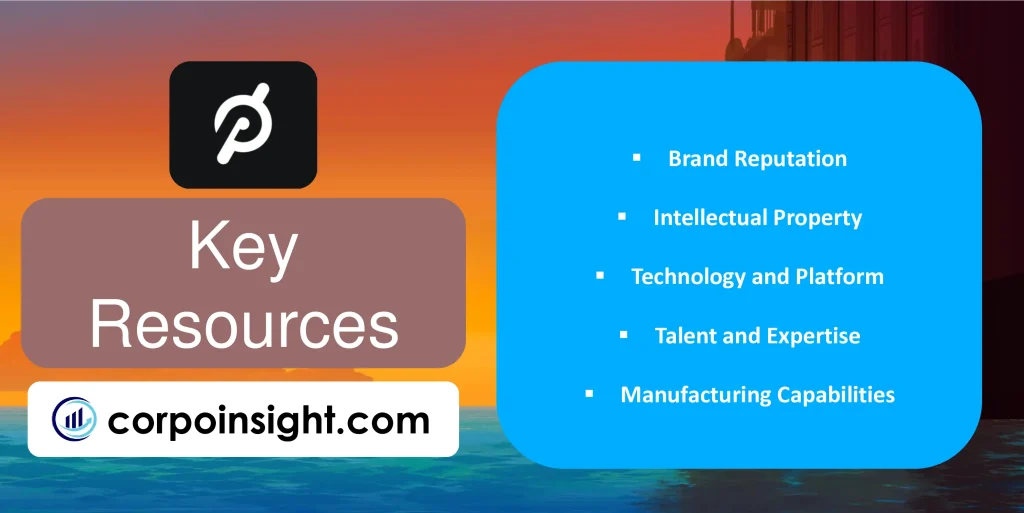
Brand Reputation: Peloton has cultivated a strong and recognizable brand reputation, associated with high-quality fitness products and a premium customer experience. This strong brand equity attracts new customers and fosters loyalty among existing ones.
Intellectual Property: Peloton owns valuable intellectual property, including patents, trademarks, and copyrights, which protect its innovative products, software, and content. This intellectual property provides a competitive advantage and enables the company to generate recurring revenue streams.
Technology and Platform: Peloton’s proprietary technology platform is a core asset, enabling the company to deliver a seamless and personalized fitness experience. This platform includes hardware, software, and data analytics capabilities, which are essential for driving customer engagement and satisfaction.
Talent and Expertise: Peloton employs a talented team of engineers, designers, instructors, and other professionals who possess deep expertise in fitness, technology, and marketing. This talented workforce is crucial for driving innovation, creating high-quality content, and delivering exceptional customer service.
Manufacturing Capabilities: Peloton has established strong manufacturing capabilities to produce its fitness equipment efficiently and cost-effectively. This includes partnerships with reliable suppliers, efficient production processes, and a robust supply chain.
Key Partners – Peloton Business Model Canvas
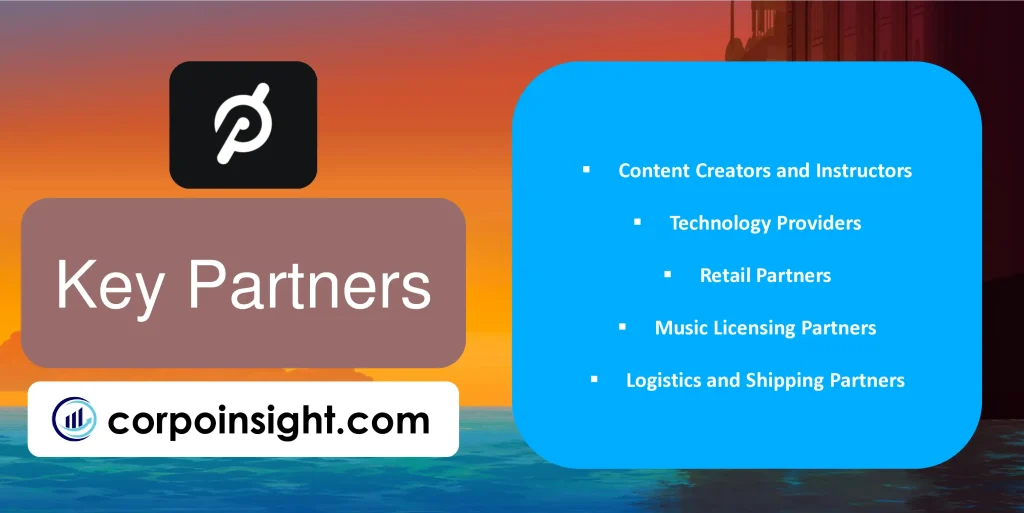
Content Creators and Instructors: Peloton collaborates with a diverse group of fitness instructors and content creators to produce high-quality workout classes. These partnerships enable Peloton to offer a wide range of workout styles and cater to the diverse preferences of its customers.
Technology Providers: Peloton partners with technology companies to develop and integrate cutting-edge hardware and software solutions into its products. These partnerships allow Peloton to stay at the forefront of technological advancements and deliver innovative fitness experiences.
Retail Partners: Peloton partners with select retailers to expand its distribution channels and reach a wider audience. These partnerships provide additional opportunities for customers to experience Peloton products firsthand and make informed purchasing decisions.
Music Licensing Partners: Peloton licenses music from various record labels and artists to create immersive and motivating workout experiences. These partnerships enhance the overall user experience and contribute to the brand’s appeal.
Logistics and Shipping Partners: Peloton relies on logistics and shipping partners to efficiently deliver its products to customers worldwide. These partnerships ensure timely and reliable delivery, which is crucial for customer satisfaction and brand reputation.
Cost Structure – Peloton Business Model Canvas
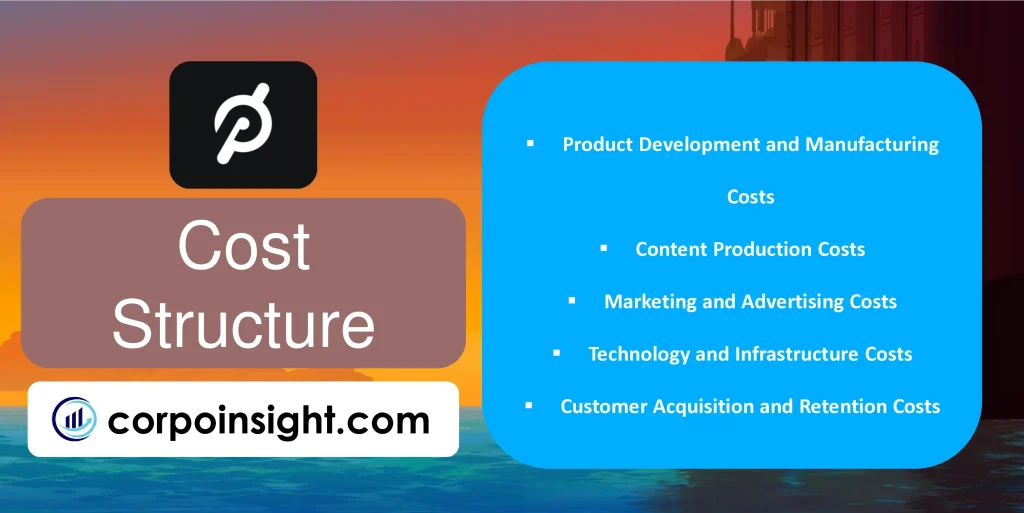
Product Development and Manufacturing Costs: Peloton incurs significant costs in designing, developing, and manufacturing its fitness equipment. These costs include research and development expenses, materials, labor, and production facility overhead.
Content Production Costs: The production of high-quality fitness content, including live and on-demand classes, requires substantial investment. Costs associated with content production include instructor fees, studio rental, equipment maintenance, and post-production editing.
Marketing and Advertising Costs: Peloton invests heavily in marketing and advertising to attract new customers and retain existing ones. These costs include digital marketing, traditional advertising, public relations, and influencer partnerships.
Technology and Infrastructure Costs: Maintaining and upgrading Peloton’s technology infrastructure, including software development, data storage, and network maintenance, is a significant cost driver. Additionally, the company invests in cybersecurity measures to protect its systems and customer data.
Customer Acquisition and Retention Costs: Peloton incurs costs associated with acquiring new customers, such as advertising, promotions, and referral programs. Additionally, the company invests in customer support, loyalty programs, and other initiatives to retain existing customers.
Summary of Peloton Business Model Canvas
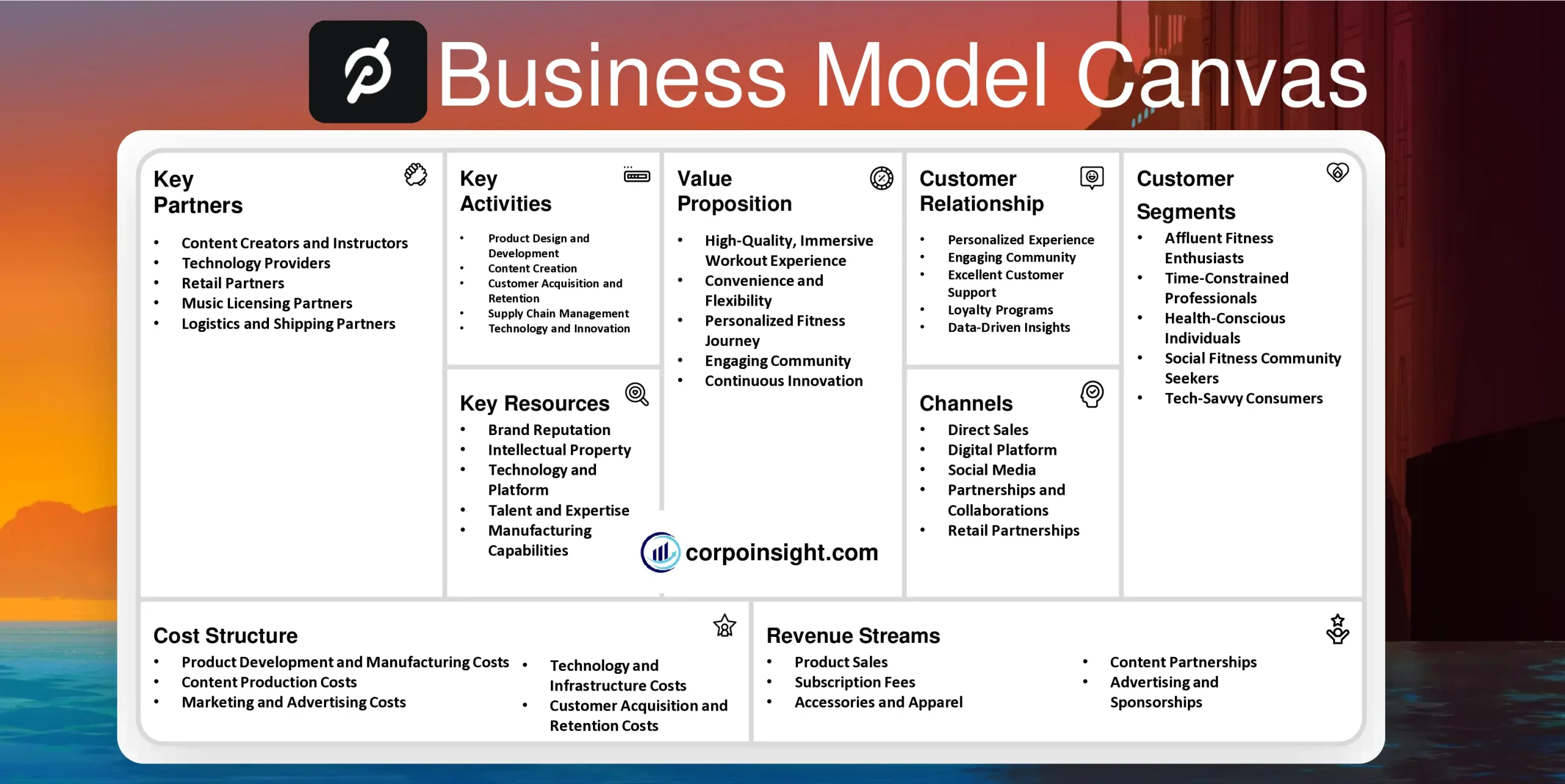
Conclusion on Peloton Business Model Canvas
Peloton’s business model hinges on its innovative fitness equipment, engaging content, and strong community. By offering a premium, personalized, and convenient workout experience, Peloton has successfully captured a significant market share. However, maintaining a competitive edge requires continuous innovation, effective cost management, and strategic partnerships to sustain long-term growth.

Majoring in marketing from Bangladesh University of Professionals, Sadman Abrar is a learner, obsessed with branding and intrigued to learn about different company strategies, and currently working at bKash.






